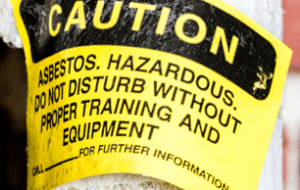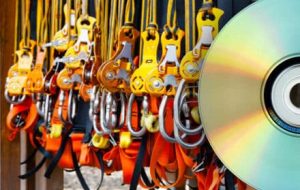1910.1001 – Asbestos
This website is not the official or final authority to determine OSHA compliance responsibilities, which are set forth in OSHA standards themselves, and the Occupational Safety and Health Act of 1970. Because OSHA regulations are constantly being added, deleted, and/or revised, you must not rely on this website as the official or final authority of OSHA training requirements; refer to the official OSHA regulations available on OSHA’s website (osha.gov). – See disclaimers.
1910.1001 – Asbestos
(b) – Definitions Applicable to This Subpart
“Certified Industrial Hygienist (CIH)” means one certified in the practice of industrial hygiene by the American Board of Industrial Hygiene.
“Industrial hygienist” means a professional qualified by education, training, and experience to anticipate, recognize, evaluate and develop controls for occupational health hazards.
(d)(7) – Employee notification of monitoring results.
(i) The employer must, within 15 working days after the receipt of the results of any monitoring performed under this sections, notify each affected employee of these results either individually in writing or by posting the results in an appropriate location that is accessible to affected employees.
(ii) The written notification required by paragraph (d)(7)(i) of this section shall contain the corrective action being taken by the employer to reduce employee exposure to or below the TWA and/or excursion limit, wherever monitoring results indicated that the TWA and/or excursion limit had been exceeded.
(g)(2) – Respirator program.
(i) The employer must implement a respiratory protection program in accordance with 29 CFR 1910.134 (b) through (d) (except (d)(1)(iii)), and (f) through (m), which covers each employee required by this section to use a respirator.
(j) – Communication of hazards to employees — Introduction. This section applies to the communication of information concerning asbestos hazards in general industry to facilitate compliance with this standard. Asbestos exposure in general industry occurs in a wide variety of industrial and commercial settings. Employees who manufacture asbestos-containing products may be exposed to asbestos fibers. Employees who repair and replace automotive brakes and clutches may be exposed to asbestos fibers. In addition, employees engaged in housekeeping activities in industrial facilities with asbestos product manufacturing operations, and in public and commercial buildings with installed asbestos containing materials may be exposed to asbestos fibers. Most of these workers are covered by this general industry standard, with the exception of state or local governmental employees in non-state plan states. It should be noted that employees who perform housekeeping activities during and after construction activities are covered by the asbestos construction standard, 29 CFR 1926.1101, formerly 1926.58. However, housekeeping employees, regardless of industry designation, should know whether building components they maintain may expose them to asbestos. The same hazard communication provisions will protect employees who perform housekeeping operations in all three asbestos standards; general industry, construction, and shipyard employment. As noted in the construction standard, building owners are often the only and/or best source of information concerning the presence of previously installed asbestos containing building materials. Therefore they, along with employers of potentially exposed employees, are assigned specific information conveying and retention duties under this section.
(2) – Duties of employers and building and facility owners.
(i) Building and facility owners shall determine the presence, location, and quantity of ACM and/or PACM at the work site. Employers and building and facility owners shall exercise due diligence in complying with these requirements to inform employers and employees about the presence and location of ACM and PACM.
(iii) Building and facility owners shall inform employers of employees, and employers shall inform employees who will perform housekeeping activities in areas which contain ACM and/or PACM of the presence and location of ACM and/or PACM in such areas which may be contacted during such activities.
(7) – Employee information and training.
(i) The employer shall train each employee who is exposed to airborne concentrations of asbestos at or above the PEL and/or excursion limit in accordance with the requirements of this section. The employer shall institute a training program and ensure employee participation in the program.
(ii) Training shall be provided prior to or at the time of initial assignment and at least annually thereafter.
(iii) The training program shall be conducted in a manner which the employee is able to understand. The employer shall ensure that each employee is informed of the following:
(A) – The health effects associated with asbestos exposure;
(B) – The relationship between smoking and exposure to asbestos producing lung cancer:
(C) – The quantity, location, manner of use, release, and storage of asbestos, and the specific nature of operations which could result in exposure to asbestos;
(D) – The engineering controls and work practices associated with the employee’s job assignment;
(E) – The specific procedures implemented to protect employees from exposure to asbestos, such as appropriate work practices, emergency and clean-up procedures, and personal protective equipment to be used;
(F) – The purpose, proper use, and limitations of respirators and protective clothing, if appropriate;
(G) – The purpose and a description of the medical surveillance program required by paragraph (l) of this section;
(H) – The content of this standard, including appendices.
(I) – The names, addresses and phone numbers of public health organizations which provide information, materials, and/or conduct programs concerning smoking cessation. The employer may distribute the list of such organizations contained in Appendix I to this section, to comply with this requirement.
(J) – The requirements for posting signs and affixing labels and the meaning of the required legends for such signs and labels.
(iv) The employer shall also provide, at no cost to employees who perform housekeeping operations in an area which contains ACM or PACM, an asbestos awareness training course, which shall at a minimum contain the following elements: health effects of asbestos, locations of ACM and PACM in the building/facility, recognition of ACM and PACM damage and deterioration, requirements in this standard relating to housekeeping, and proper response to fiber release episodes, to all employees who perform housekeeping work in areas where ACM and/or PACM is present. Each such employee shall be so trained at least once a year.
(v) Access to information and training materials.
(A) – The employer shall make a copy of this standard and its appendices readily available without cost to all affected employees.
(B) – The employer shall provide, upon request, all materials relating to the employee information and training program to the Assistant Secretary and the training program to the Assistant Secretary and the Director.
(C) – The employer shall inform all employees concerning the availability of self-help smoking cessation program material. Upon employee request, the employer shall distribute such material, consisting of NIH Publication No. 89-1647, or equivalent self-help material, which is approved or published by a public health organization listed in Appendix I to this section.
(8) – Criteria to rebut the designation of installed material as PACM.
(iii) – The employer and/or building owner may demonstrate that flooring material including associated mastic and backing does not contain asbestos, by a determination of an industrial hygienist based upon recognized analytical techniques showing that the material is not ACM.
(l) – Medical Surveillance
(7)(iii) – The employer shall provide a copy of the physician’s written opinion to the affected employee within 30 days from its receipt.
(m) – Recordkeeping
(4) – Training. The employer shall maintain all employee training records for one (1) year beyond the last date of employment of that employee.
(n) – Observation of monitoring
(1) – Employee observation. The employer shall provide affected employees or their designated representatives an opportunity to observe any monitoring of employee exposure to asbestos conducted in accordance with paragraph (d) of this section.

On Site OSHA Training Classes
OSHA authorized OSHA trainer comes to your site to conduct an OSHA training class for your group of 10 or more trainees.

Online Asbestos Awareness Course
On demand OSHA training courses for all the most popular topics, including Asbestos awareness training for affected workers.

Asbestos Awareness Training DVD with Leader's Guide
Conduct OSHA training in-house with our Asbestos Awareness training DVD with a leader's guide.
